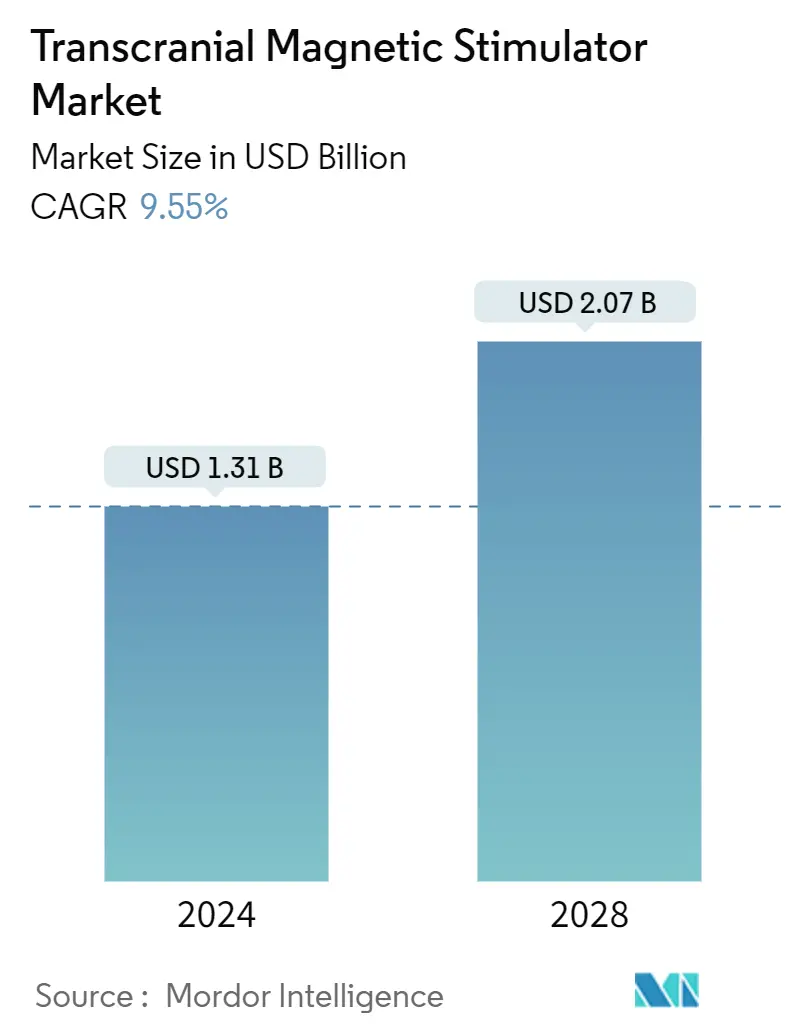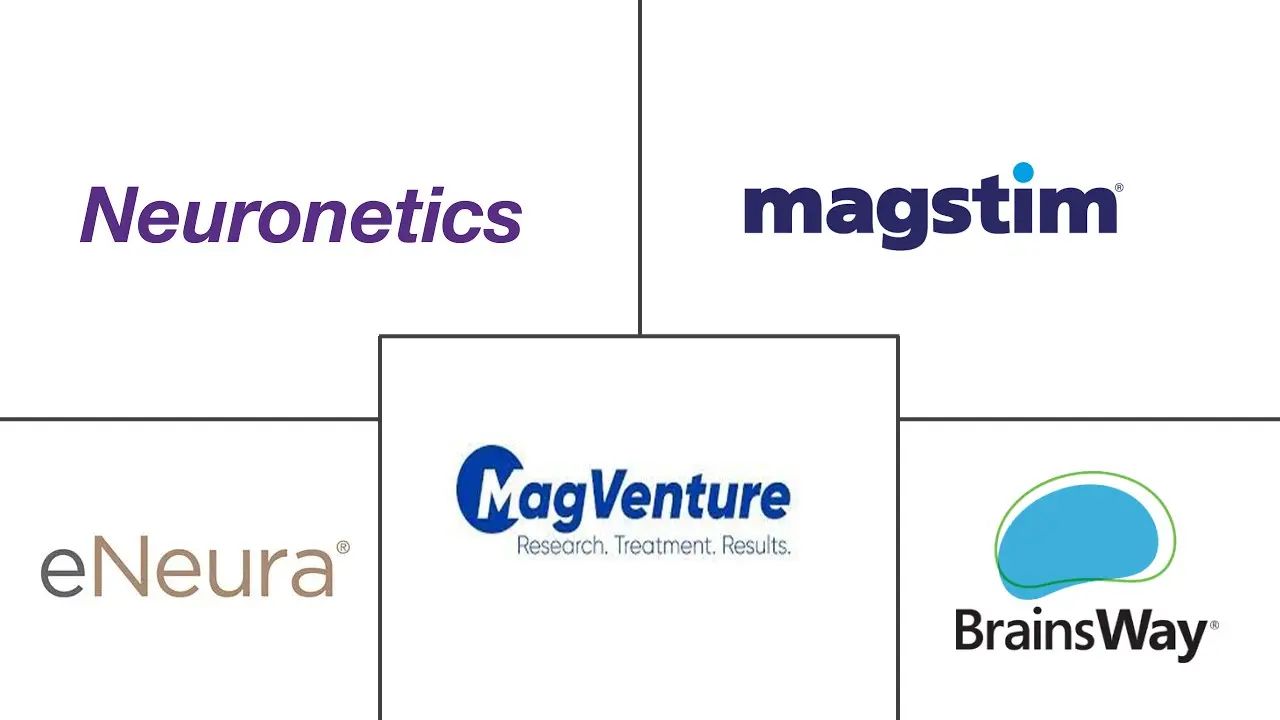Market Size of Transcranial Magnetic Stimulator Industry

| Study Period | 2018-2022 |
| Market Size (2024) | USD 1.31 Billion |
| Market Size (2028) | USD 2.07 Billion |
| CAGR (2024 - 2028) | 9.55 % |
| Fastest Growing Market | North America |
| Largest Market | Asia Pacific |
| Market Concentration | Medium |
Major Players
*Disclaimer: Major Players sorted in no particular order |
Transcranial Magnetic Stimulator Market Analysis
The Transcranial Magnetic Stimulator Market size is estimated at USD 1.31 billion in 2024, and is expected to reach USD 2.07 billion by 2028, growing at a CAGR of 9.55% during the forecast period (2024-2028).
The COVID-19 pandemic had varied effects on industries, including transcranial magnetic stimulators. Some companies in the healthcare sector experienced disruptions due to changes in healthcare priorities and supply chain challenges. For instance, as per the annual report of Neuronetics Inc. published in 2022, the company experienced material delays in obtaining components, and the supply of finished products to customers or clinicians in 2021, and it has been adversely affected by component supply issues and a decline in the sales of NeuroStar a TMS system. Hence, initial phase of the pandemic TMS sales decrease has impacted the market. However, post-pandemic the sales of TMS systems from the company increased by 64% or 4.6 million in 2022. Hence, the market was impacted in the initial phase of the pandemic due to supply disruption and it is expected that the market will bounce back with increasing installation of TMS systems across globe.
The growing burden of neurological diseases drives the market, the increasing geriatric population, and rising awareness of the TMS system.
According to the World Health Organisation's data updated in February 2022, around 50 million people worldwide suffer from epilepsy every year. Further, according to the World Alzheimer's Report 2023, an estimated 6.7 million Americans aged 65 and older will be living with Alzheimer’s dementia in 2023. Seventy-three percent are age 75 or older. Further, according to the National Health Service (NHS) England updates from April 2022, around 1 in 12,500 people in England will have a ruptured brain aneurysm every year. Furthermore, around 3.0% of adults in the United Kingdom have a cerebral aneurysm. Thus, given the high incidence of neurological disorders globally, the vast and rapidly growing patient population base for target diseases across the key markets is primarily responsible for the transcranial magnetic stimulator, leading to market growth.
Companies are constantly launching new products in the existing market to expand their product portfolio and increase the revenue of the company. For instance, in July 2022, Neuronetics, recieved the FDA approval for their NeuroStar Advanced Therapy for Mental Health transcranial magnetic stimulation device for treating anxiety symptoms in people with major depressive disorder. Additionally, in January 2023, Magstim, a global leader in neuroscience research and Transcranial Magnetic Stimulation (TMS) solutions for mental health announced that the FDA has cleared the Horizon 3.0 (with or without StimGuide+) and E-z Cool Coil to treat adult patients diagnosed with obsessive-compulsive disorder (OCD) as well as major depressive disorder (MDD). Thus, introduction of such product launches is expected to boost the market over the forecast period.
Hence, the growing burden of neurological diseases and strategic activities by the market players is expected to contribute to the market growth over the forecast period. However, the growing shift towards electroconvulsive therapy is expected to restrain the market over the forecast period.
Transcranial Magnetic Stimulator Industry Segmentation
As per the scope of the report, transcranial magnetic stimulation (TMS) is a non-invasive process of brain stimulation that practices magnetic induction forces focusing on a critical area of the brain. The electromagnetic induction is produced from a coil using electricity, and these pulses go through the cranium to its particular receptor area of the brain.
The transcranial magnetic stimulation market is segmented by type (deep transcranial magnetic stimulation, repetitive transcranial magnetic stimulation, and other types) and application (Alzheimer’s disease, depression, Parkinson’s disease, epilepsy, and other applications). Age group (adults and children) and geography (North America, Europe, Asia-Pacific, the Middle East and Africa, and South America). The market report also covers the estimated market sizes and trends for 17 countries across major regions globally.
The report offers the value (in USD) for the above segments.
| By Type | |
| Deep Transcranial Magnetic Stimulation | |
| Repetitive Transcranial Magnetic Stimulation | |
| Other Types |
| By Application | |
| Alzheimers Disease | |
| Depression | |
| Parkinson's Disease | |
| Epilepsy | |
| Other Applications |
| By Age Group | |
| Adults | |
| Children |
| Geography | ||||||||
| ||||||||
| ||||||||
| ||||||||
| ||||||||
|
Transcranial Magnetic Stimulator Market Size Summary
The transcranial magnetic stimulator market is poised for significant growth, driven by the increasing prevalence of neurological disorders and the expanding geriatric population. The market is experiencing a resurgence post-pandemic, with companies like Neuronetics Inc. reporting substantial sales increases after initial COVID-19-related disruptions. The rising awareness and adoption of TMS systems, coupled with strategic product launches and regulatory approvals, are further propelling market expansion. The introduction of advanced therapies for mental health conditions, such as anxiety and depression, underscores the growing demand for TMS solutions. Despite challenges from alternative treatments like electroconvulsive therapy, the market's trajectory remains positive, supported by ongoing research and development activities.
North America is expected to maintain a significant market share, bolstered by a high prevalence of neurological disorders and a robust clinical pipeline. The region's market growth is further enhanced by the presence of key industry players and a strong focus on research and development. The increasing incidence of conditions such as Alzheimer's and depression, along with the aging population, contributes to the region's market dynamics. The market is moderately consolidated, with major players engaging in strategic partnerships, product launches, and research collaborations to strengthen their market position. These efforts are anticipated to drive the market forward, with a focus on expanding the availability and efficacy of TMS systems globally.
Transcranial Magnetic Stimulator Market Size - Table of Contents
-
1. MARKET DYNAMICS
-
1.1 Market Overview
-
1.2 Market Drivers
-
1.2.1 Growing Burden of Neurological Diseases
-
1.2.2 Increasing Geriatric Population and Expanding Awareness About Transcranial Magnetic Stimulation (TMS).
-
-
1.3 Market Restraints
-
1.3.1 Growing Shift Towards Electroconvulsive Therapy
-
-
1.4 Porter's Five Forces Analysis
-
1.4.1 Bargaining Power of Suppliers
-
1.4.2 Bargaining Power of Buyers/Consumers
-
1.4.3 Threat of New Entrants
-
1.4.4 Threat of Substitute Products
-
1.4.5 Intensity of Competitive Rivalry
-
-
-
2. MARKET SEGMENTATION (Market Size by Value – USD)
-
2.1 By Type
-
2.1.1 Deep Transcranial Magnetic Stimulation
-
2.1.2 Repetitive Transcranial Magnetic Stimulation
-
2.1.3 Other Types
-
-
2.2 By Application
-
2.2.1 Alzheimers Disease
-
2.2.2 Depression
-
2.2.3 Parkinson's Disease
-
2.2.4 Epilepsy
-
2.2.5 Other Applications
-
-
2.3 By Age Group
-
2.3.1 Adults
-
2.3.2 Children
-
-
2.4 Geography
-
2.4.1 North America
-
2.4.1.1 United States
-
2.4.1.2 Canada
-
2.4.1.3 Mexico
-
-
2.4.2 Europe
-
2.4.2.1 United Kingdom
-
2.4.2.2 Germany
-
2.4.2.3 France
-
2.4.2.4 Spain
-
2.4.2.5 Italy
-
2.4.2.6 Rest of Europe
-
-
2.4.3 Asia-Pacific
-
2.4.3.1 India
-
2.4.3.2 Japan
-
2.4.3.3 China
-
2.4.3.4 Australia
-
2.4.3.5 South Korea
-
2.4.3.6 Rest of Asia-Pacific
-
-
2.4.4 Middle East and Africa
-
2.4.4.1 GCC
-
2.4.4.2 South Africa
-
2.4.4.3 Rest of the Middle East and Africa
-
-
2.4.5 South America
-
2.4.5.1 Brazil
-
2.4.5.2 Argentina
-
2.4.5.3 Rest of South America
-
-
-
Transcranial Magnetic Stimulator Market Size FAQs
How big is the Transcranial Magnetic Stimulator Market?
The Transcranial Magnetic Stimulator Market size is expected to reach USD 1.31 billion in 2024 and grow at a CAGR of 9.55% to reach USD 2.07 billion by 2028.
What is the current Transcranial Magnetic Stimulator Market size?
In 2024, the Transcranial Magnetic Stimulator Market size is expected to reach USD 1.31 billion.

